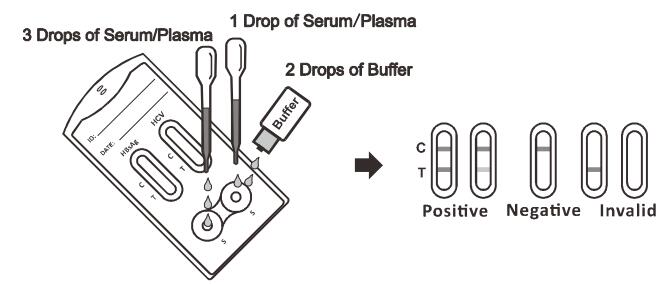Description
【SUMMARY】
The HBsAg Rapid Test (Serum /Plasma) is a rapid test to qualitatively detect the presence of HBsAg in serum or plasma specimen. The test utilizes a combination of monoclonal and polyclonal antibodies to selectively detect elevated levels of HBsAg in serum or plasma. Viral hepatitis is a systemic disease primarily involving the liver. Most cases of acute viral hepatitis are caused by Hepatitis A virus, Hepatitis B virus (HBV) or Hepatitis C virus. The complex antigen found on the surface of HBV is called HBsAg. Previous designations included the Australia or Au antigen. The presence of HBsAg in serum or plasma is an indication of an active Hepatitis B infection, either acute or chronic. In a typical Hepatitis B infection, HBsAg will be detected 2 to 4 weeks before the ALT level becomes abnormal and 3 to 5 weeks before symptoms or jaundice develop. HBsAg has four principal subtypes: adw, ayw, adr and ayr. Because of antigenic heterogeneity of the determinant, there are 10 major serotypes of Hepatitis B virus.
The HCV Rapid Test (Serum /Plasma) is a rapid test to qualitatively detect the presence of antibody to HCV in a serum or plasma specimen. The test utilizes colloid gold conjugate and recombinant HCV proteins to selectively detect antibody to HCV in serum or plasma. The recombinant HCV proteins used in the test kit are encoded by the genes for both structural (nucleocapsid) and non-structural proteins. Hepatitis C Virus (HCV) is a small, enveloped, positive-sense, single-stranded RNA Virus. HCV is now known to be the major cause of parenterally transmitted non-A, non-B hepatitis. Antibody to HCV is found in over 80% of patients with well-documented non-A, non-B hepatitis. Conventional methods fail to isolate the virus in cell culture or visualize it by electron microscope. Cloning the viral genome has made it possible to develop serologic assays that use recombinant antigens. Compared to the first generation HCV EIAs using single recombinant antigen, multiple antigens using recombinant protein and/or synthetic peptides have been added in new serologic tests to avoid nonspecific cross-reactivity and to increase the sensitivity of the HCV antibody tests.
【DIRECTIONS FOR USE】
Allow test cassette, specimen, and/or controls to equilibrate to room temperature (15-30°C) prior to testing.
1. Bring the pouch to room temperature before opening it. Remove the test cassette from the sealed pouch and use it as soon as possible. Best results will be obtained if the assay is performed within one hour.
2. Place the test cassette on a clean and level surface.
For HBsAg
· Hold the dropper vertically and transfer 3 drops of serum or plasma (approx. 75 ul) to the specimen area. Start the timer. See the illustration below.
For HCV
· Hold the dropper vertically and transfer 1 drop of serum or plasma (approx. 25 ul) to the specimen area, then add 2 drops of buffer (approx. 80 ul) and start the timer immediately. See the illustration below.
3. Wait for the colored line(s) to appear. The test result should be read at 10 minutes.
Do not interpret the result after 20 minutes.

|
Cat. No. |
Product Description |
Specimen |
Format |
Kit Size |
Cut-Off |
Status |
|
IHBC-325 |
HBsAg and HCV Combo Rapid Test Cassette |
S / P |
Cassette |
25 T |
See Insert |
Non-CE |
More detail about Setia Scientific Solution

 Malaysia
Malaysia